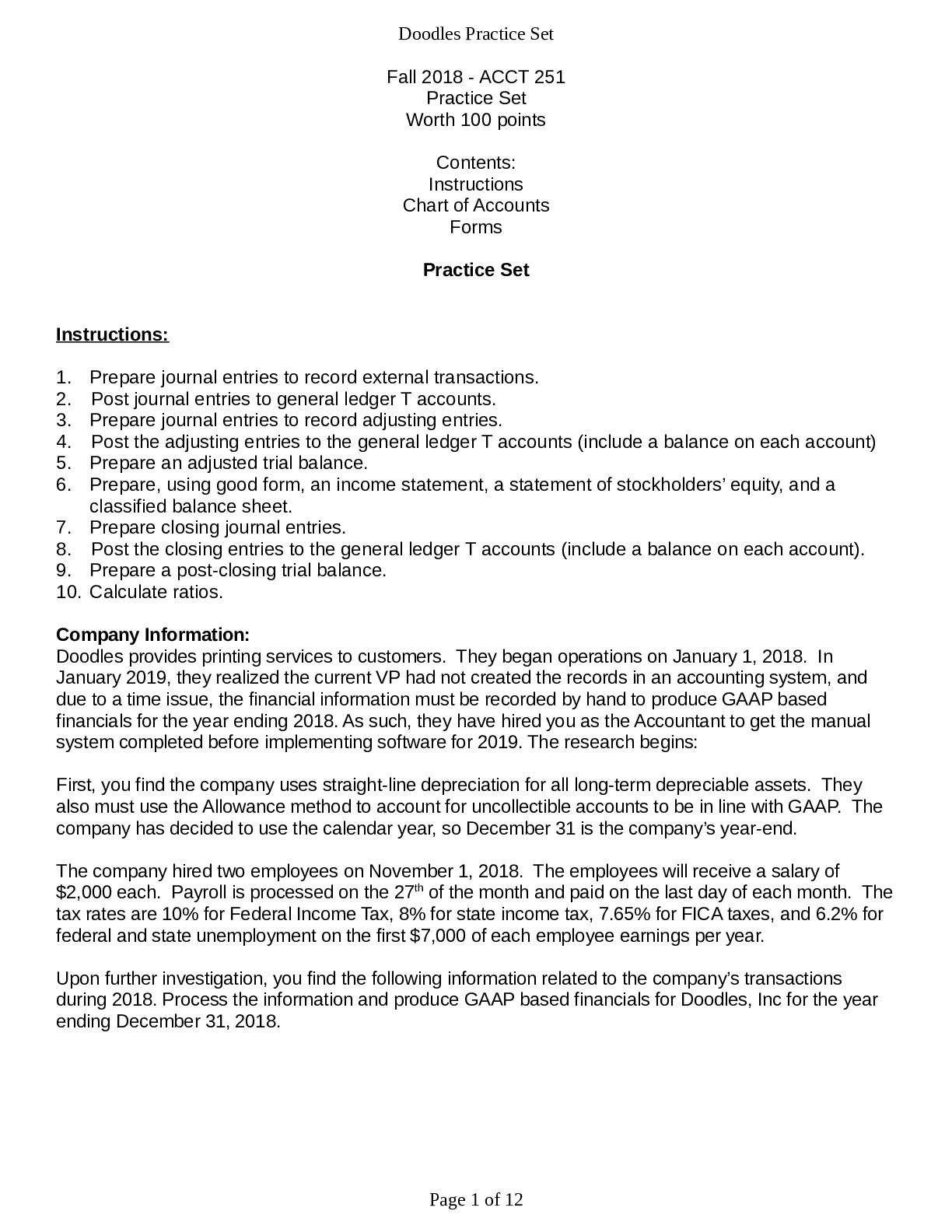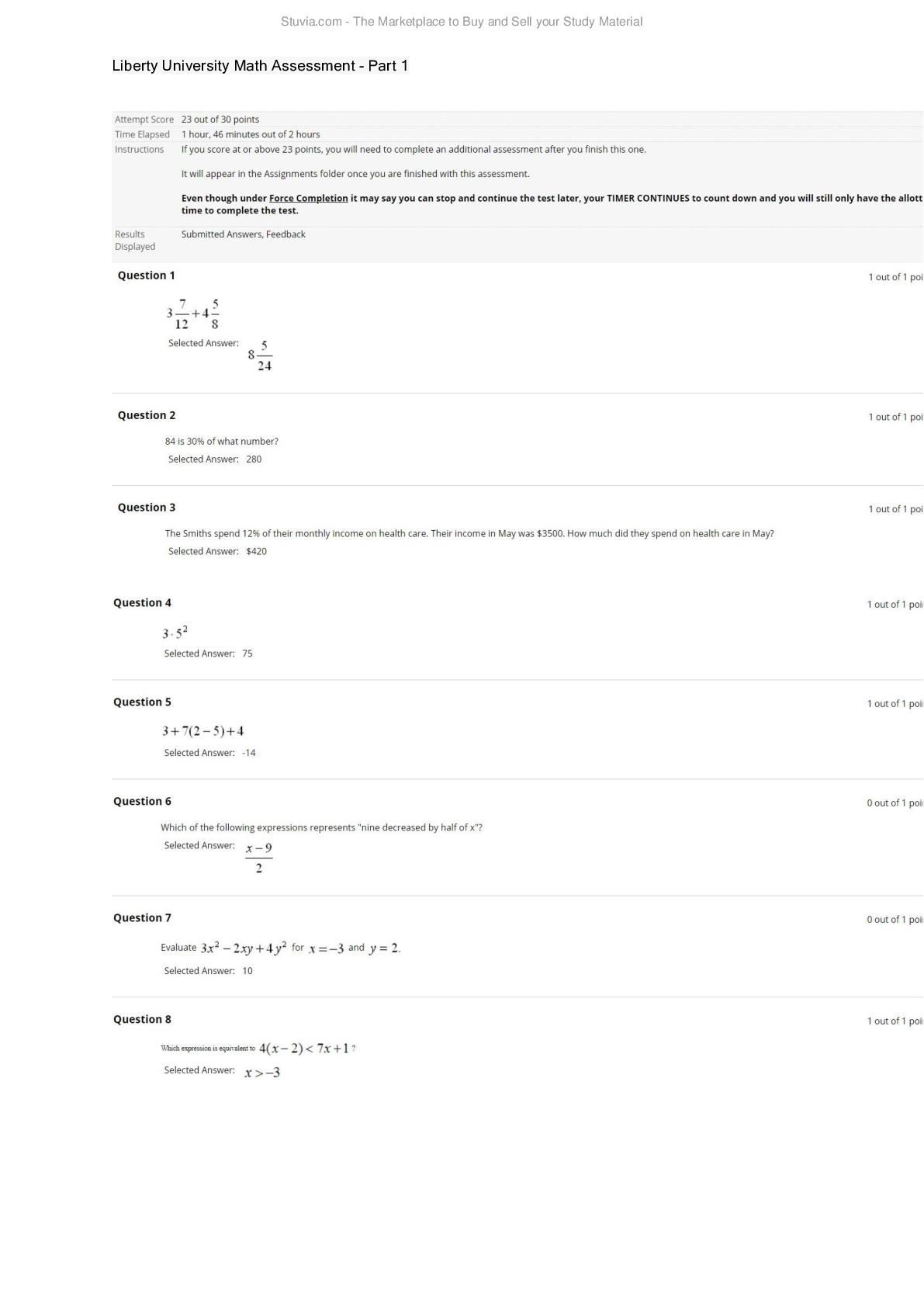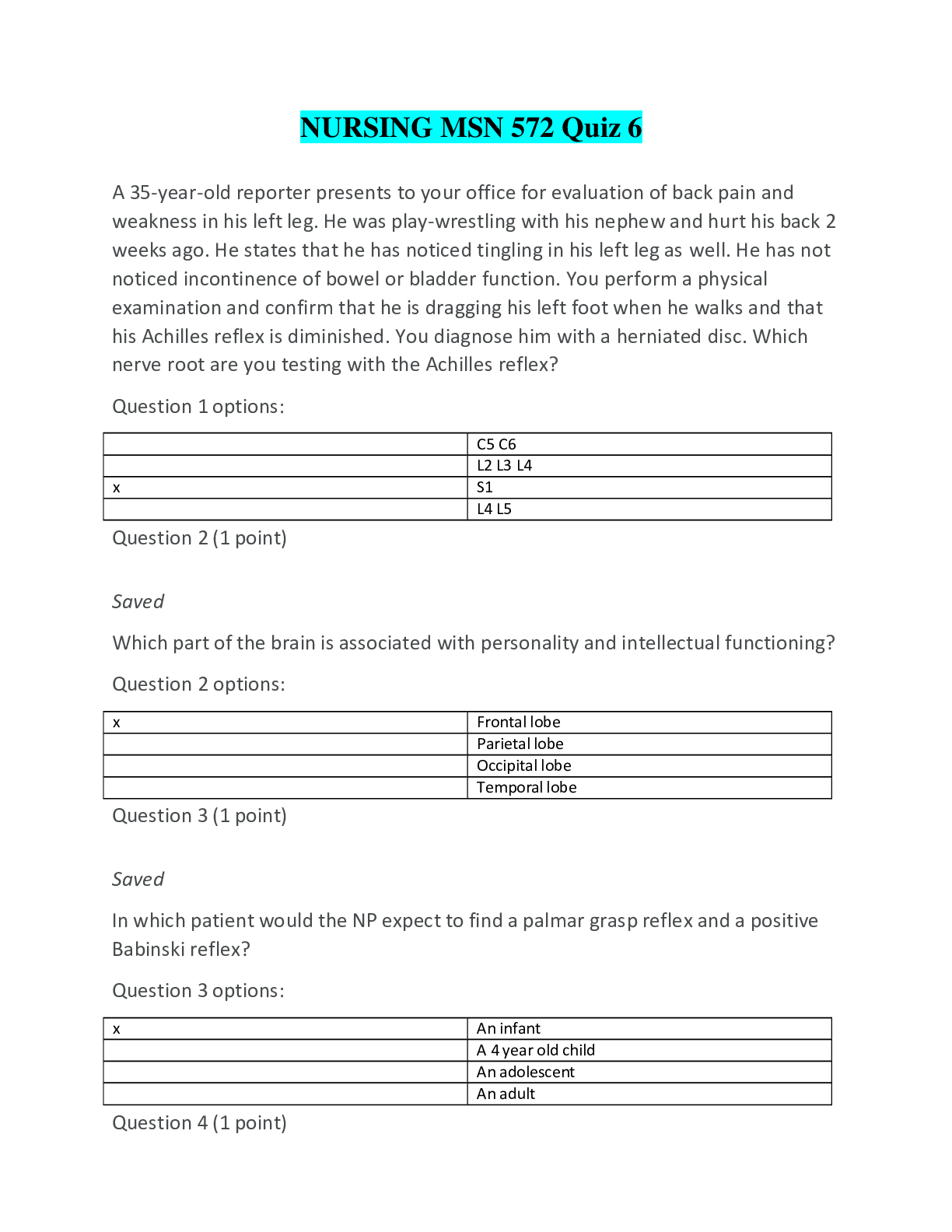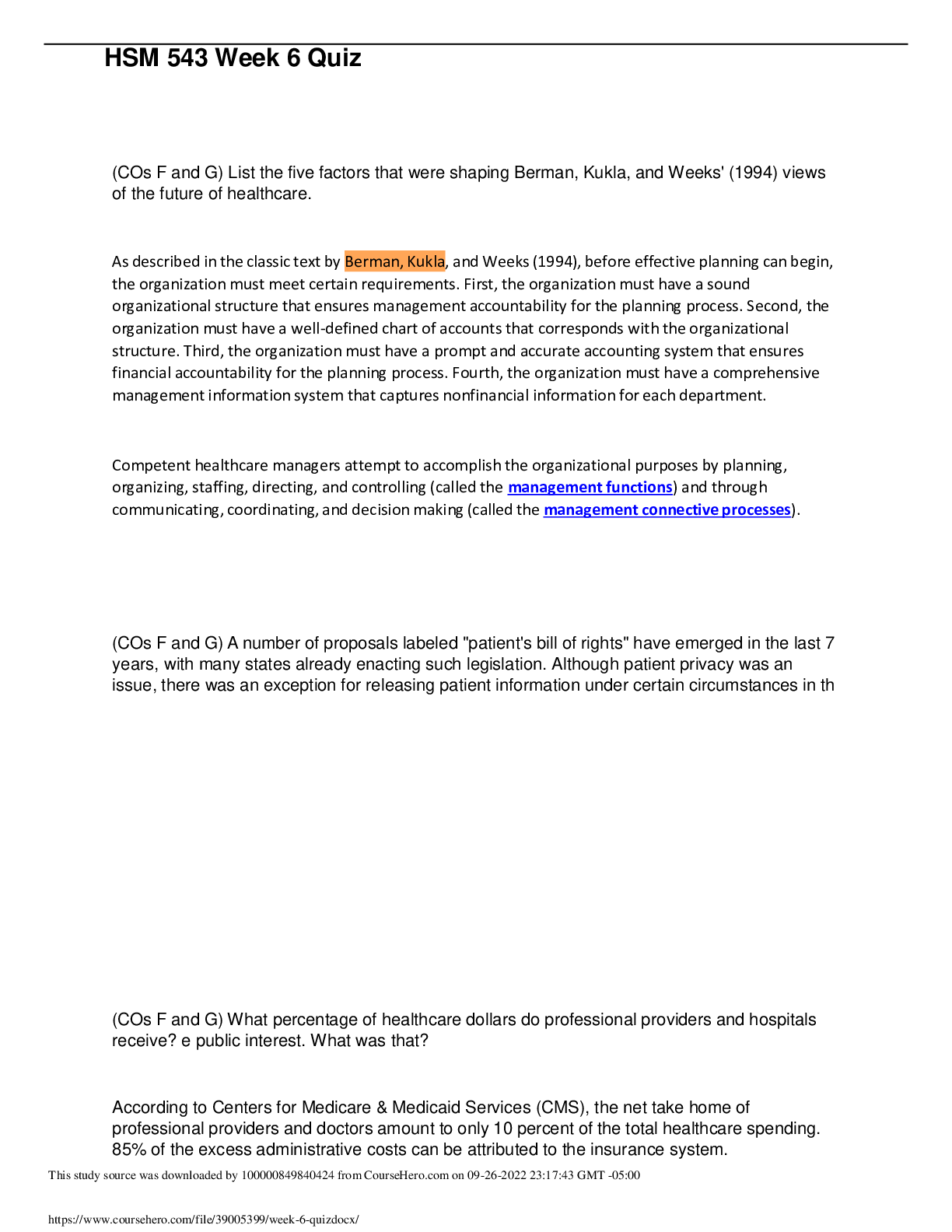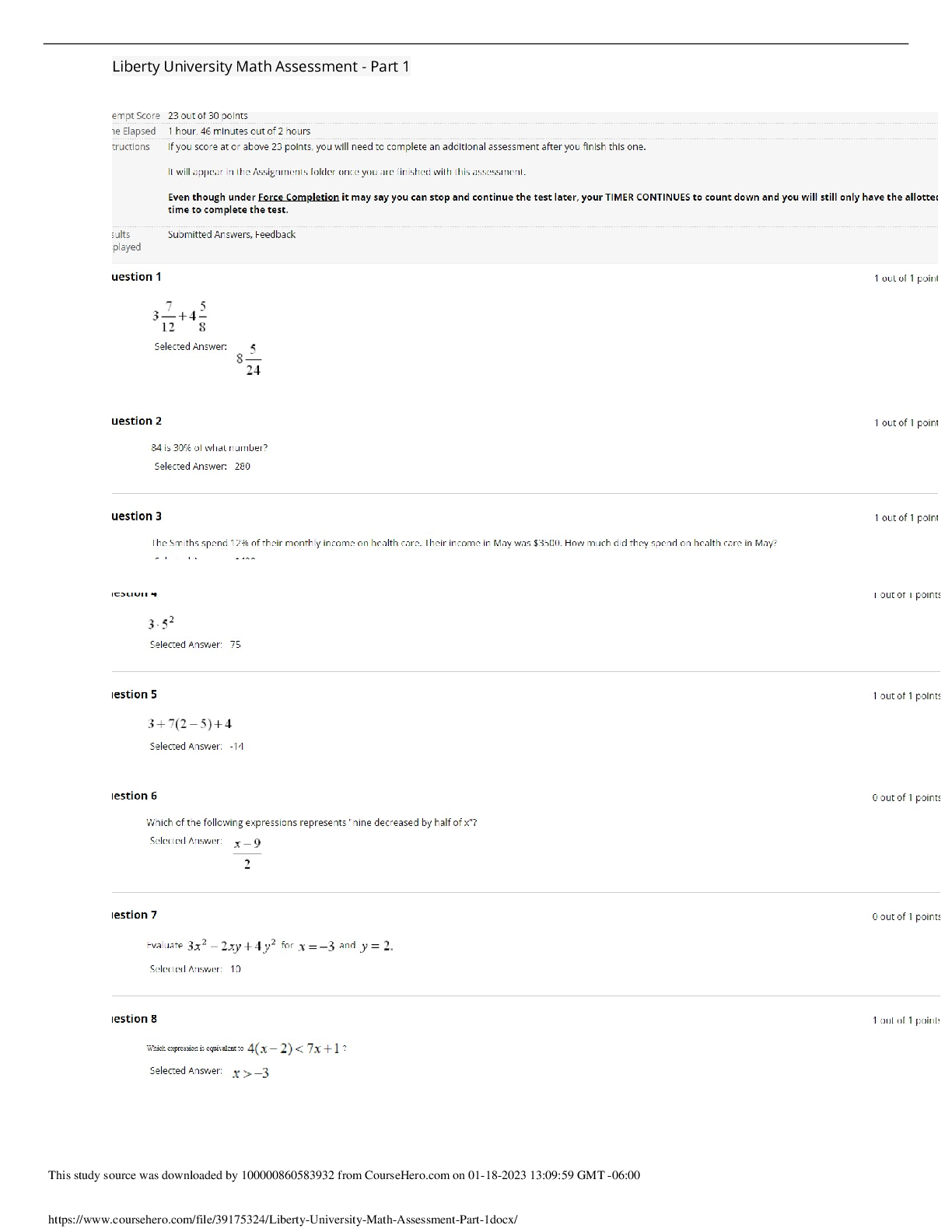Business > EXAM > American Public University - ACC 300 Assignment 16. Score: 30 out of 30 points (100%) (All)
American Public University - ACC 300 Assignment 16. Score: 30 out of 30 points (100%)
Document Content and Description Below
Score: 30 out of 30 points (100%) 1. The following table shows orders to be processed at a machine shop as of 8:00 a.m. Monday. The jobs have different operations they must go through. Processi... ng times are in days. Jobs are listed in order of arrival. Job Processing Time (Days) Due Date (Days) Remaining Number of Operations a. Determine the processing sequence at the first work center using each of these rules: (1) First come, first served, (2) Slack per operation. Sequence for First come, first served A-B-C-D-E Sequence for Slack per operation B-D-C-A-E b. Compute the effectiveness of each rule using each of these measures: (1) average completion time, (2) average number of jobs at the work center. (Round your answers to 2 decimal places.) First Come, First Served Slack per Operation Average completion time 25.20 26.80 Average number of jobs 2.93 3.10 Worksheet Learning Objective: 16-07 Use the assignment method for loading. Problem 16-8 Learning Objective: 16-08 Give examples of commonly used priority rules. The following table shows orders to be processed at a machine shop as of 8:00 a.m. Monday. The jobs have different operations they must go through. Processing times are in days. Jobs are listed in order of arrival. Job Processing Time (Days) Due Date (Days) Remaining Number of Operations a. Determine the processing sequence at the first work center using each of these rules: (1) First come, first served, (2) Slack per operation. Sequence for First come, first served A-B-C-D-E Sequence for Slack per operation B-D-C-A-E b. Compute the effectiveness of each rule using each of these measures: (1) average completion time, (2) average number of jobs at the work center. (Round your answers to 2 decimal places.) First Come, First Served Slack per Operation Average completion time 25.20 ± 0. Explanation: a. (1) First come, first served: (2) Slack per operation: Job Time (Days) Due Date (Days) Slack b. First Come, First Served Job Time (Days) Flow Time (Days) Due Date (Days) Days Tardy Slack per operation: [Assume B–D–C–A–E] Job Time (Days) Flow Time (Days) Due Date (Days) Days Tardy 2. award: 10 out of 10.00 points First Come, First Served Slack per Operation Average flow time = Flow time 126 = 25.20 days 134 = 26.80 days Number of jobs 5 5 Average number of jobs in the system = Flow time 126 = 2.93 jobs 134 = 3.12 jobs Σ Job times 43 43 Problem 16-17 Given the following information on job times and due dates. Job Job Time (Hours) Due Date a-1. Determine the optimal processing sequence using (1) First come, first served, (2) Shortest processing time, (3) Earliest due date, and (4) Critical ratio. Sequence for First come, first served a-b-c-d-e-f Sequence for Shortest processing time b-e-a-c-d-f Sequence for Earliest due date e-b-a-c-f-d Sequence for Critical ratio e-a-b-f-c-d a-2. For each method, find the average job flow time and the average job tardiness. (Round your answers to 2 decimal places.) First Come, First Served Shortest Processing Time Earliest Due Date Critical Ratio Average flow time 12.50 11.33 11.58 12.08 Average job tardiness 2.83 0.83 0.42 0.67 Worksheet Learning Objective: 16-06 Use and interpret Gantt charts. Problem 16-17 Learning Objective: 16-07 Use the assignment method for loading. Problem 16-17 Given the following information on job times and due dates. a-1. Determine the optimal processing sequence using (1) First come, first served, (2) Shortest processing time, (3) Earliest due date, and (4) Critical ratio. Sequence for First come, first served a-b-c-d-e-f Sequence for Shortest processing time b-e-a-c-d-f Sequence for Earliest due date e-b-a-c-f-d Sequence for Critical ratio e-a-b-f-c-d a-2. For each method, find the average job flow time and the average job tardiness. (Round your answers to 2 decimal places.) First Come, First Served Shortest Processing Time Earliest Due Date Critical Ratio Average flow time a-1. First come, first served Job e has the lowest critical ratio, therefore it is scheduled first and completed after 2.5 hours. The revised critical ratios are: Job Processing Time (Days) Due Job a is scheduled next because Job a has the lowest critical ratio. Job a will be completed after 6 hours (2.5 + 3.5). After the completion of Job a, the revised critical ratios are: Job Processing Time (Days) Due Date Critical Ratio Calculation Since Job b has the lowest critical ratio, it is scheduled next and it is completed after 8 hours (6 + 2). After the completion of Job b, the revised critical ratios are: Job Processing Time (Days) Due Date Critical Ratio Calculation Since Job f has the lowest critical ratio, it is scheduled next and it will be completed after 14 hours (8 + 6). After the completion of Job f, the revised critical ratios are: Job Processing Time (Days) Due Date Critical Ratio Calculation Since Job c has the lowest critical ratio, it is scheduled next. Job c will be completed after 18.5 hours. The final critical ratio sequence of all jobs is e–a–b–f–c–d. Total completion of all six jobs (makespan) is 23.5 hours. Critical First Served Shortest Processing Time Earliest Due Date Critical Ratio Average flow time = Flow time 12.5 11.33 11.58 72.5 = 12.08 hours Number of jobs 6 Average job tardiness = Hours late 2.83 0.83 0.42 4 = 0.67 hours Number of jobs 6 Problem 16-18 The Budd Gear Co. specializes in heat-treating gears for automobile companies. At 8:00 a.m., when Budd’s shop opened today, five orders (listed in order of arrival) were waiting to be processed. Order Order Size (units) Per Unit Time in Heat Treatment (minutes/unit) Due Date (min. from now) a. If the due date rule is used, what sequence should be used? The sequence is A-C-D-B-E . b. What will be the average job tardiness? (Round your answer to 2 decimal places.) Average job tardiness 15.20 c. What will be the average number of jobs in the system? (Round your answer to 2 decimal places.) Average number of jobs 3.31 d. Would the Shortest processing time rule produce better results in terms of average job tardiness? (Round your answer to the nearest whole number.) Yes new average job tardiness is 12 minutes. Worksheet Learning Objective: 16-06 Use and interpret Gantt charts. Problem 16-18 Learning Objective: 16-07 Use the assignment method for loading. Problem 16-18 The Budd Gear Co. specializes in heat-treating gears for automobile companies. At 8:00 a.m., when Budd’s shop opened today, five orders (listed in order of arrival) were waiting to be processed. Order Order Size (units) Per Unit Time in Heat Treatment (minutes/unit) Due Date (min. from now) a. If the due date rule is used, what sequence should be used? The sequence is A-C-D-B-E. b. What will be the average job tardiness? (Round your answer to 2 decimal places.) Average job tardiness 15.20 ± 0.05 c. What will be the average number of jobs in the system? (Round your answer to 2 decimal places.) Average number of jobs 3.31 ± 0.05 d. Would the Shortest processing time rule produce better results in terms of average job tardiness? (Round your answer to the nearest whole number.) Yes new average job tardiness is 12 minutes. Explanation: a. Order Job Time b. Average job tardiness = Total hours tardy / Number of jobs Average job tardiness = 76 / 5 = 15.2 minutes c. Average number of jobs = Total flow time / Makespan Average number of jobs in the system = 828 / 250 = 3.31 d. Shortest processing time Time Due Average job tardiness = Total hours tardy / Number of jobs Average job tardiness = 60 / 5 = 12 minutes [Show More]
Last updated: 1 year ago
Preview 1 out of 8 pages
Instant download

Buy this document to get the full access instantly
Instant Download Access after purchase
Add to cartInstant download
Reviews( 0 )
Document information
Connected school, study & course
About the document
Uploaded On
Feb 17, 2021
Number of pages
8
Written in
Additional information
This document has been written for:
Uploaded
Feb 17, 2021
Downloads
0
Views
52



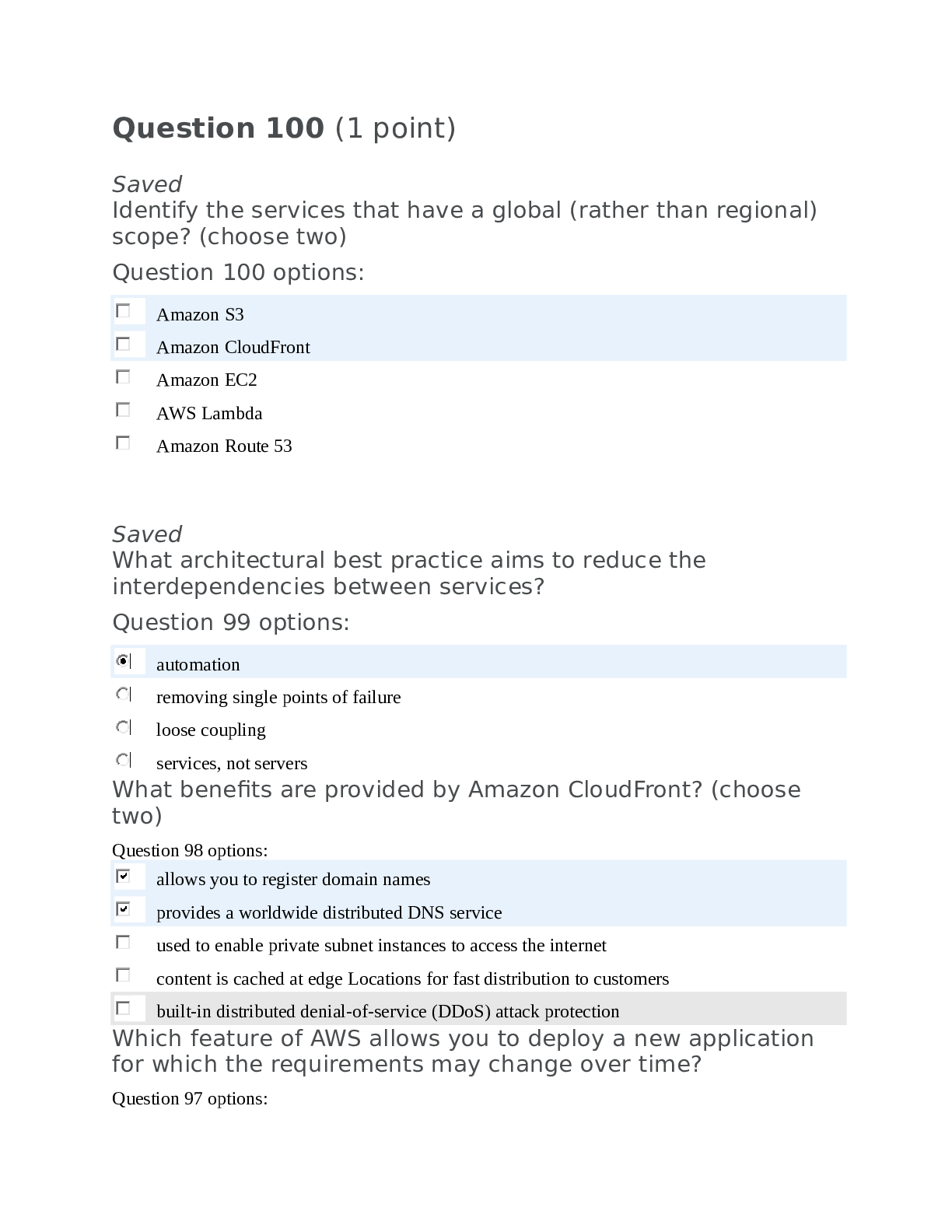

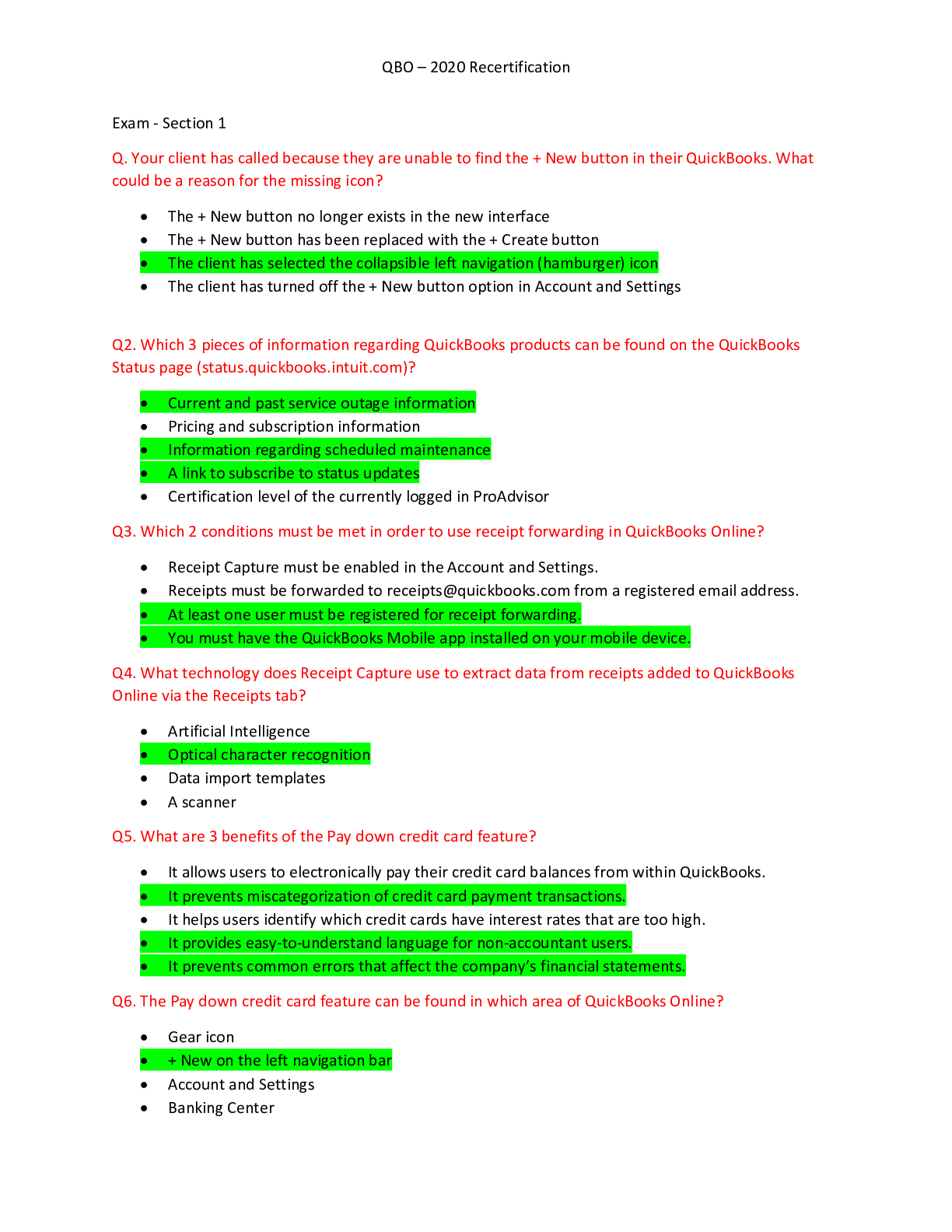
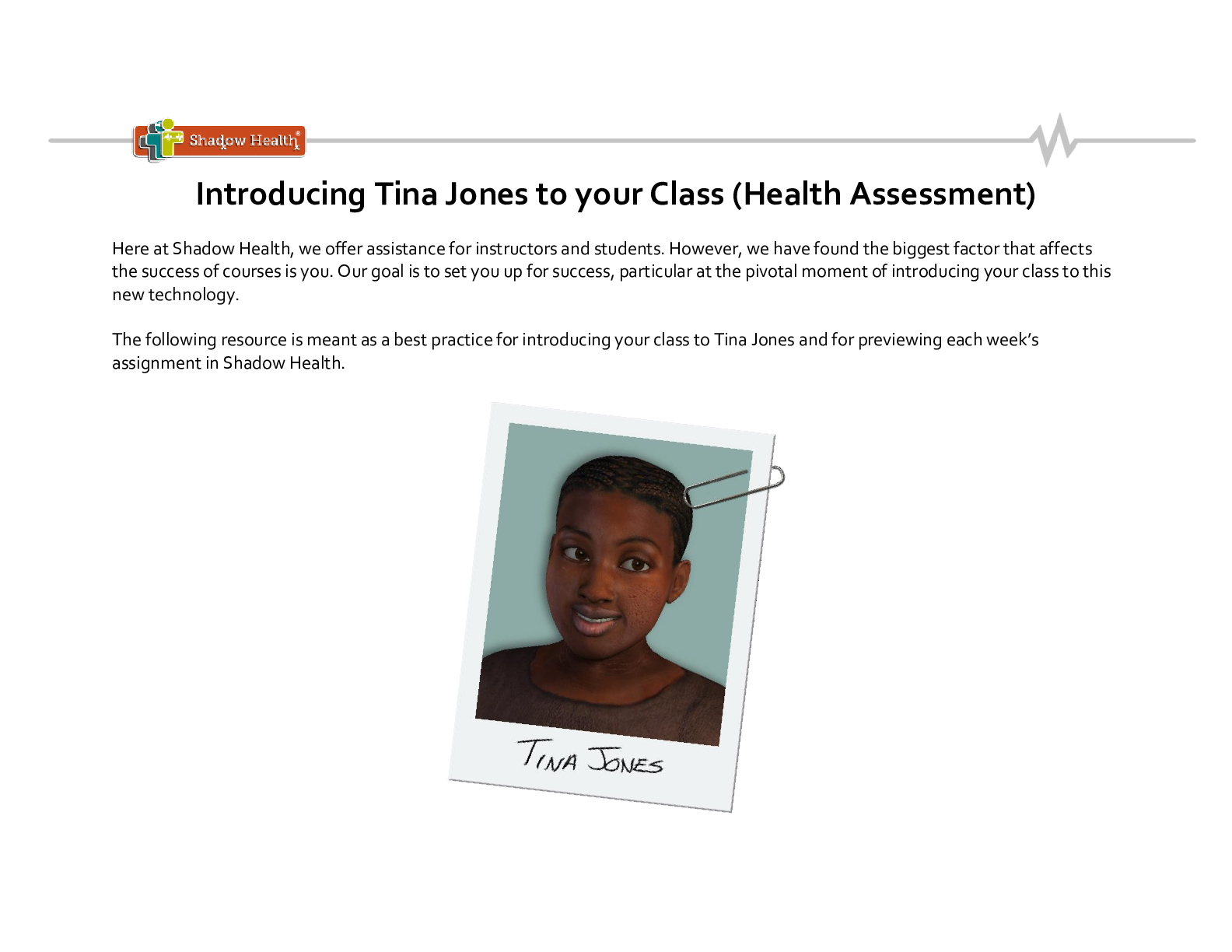


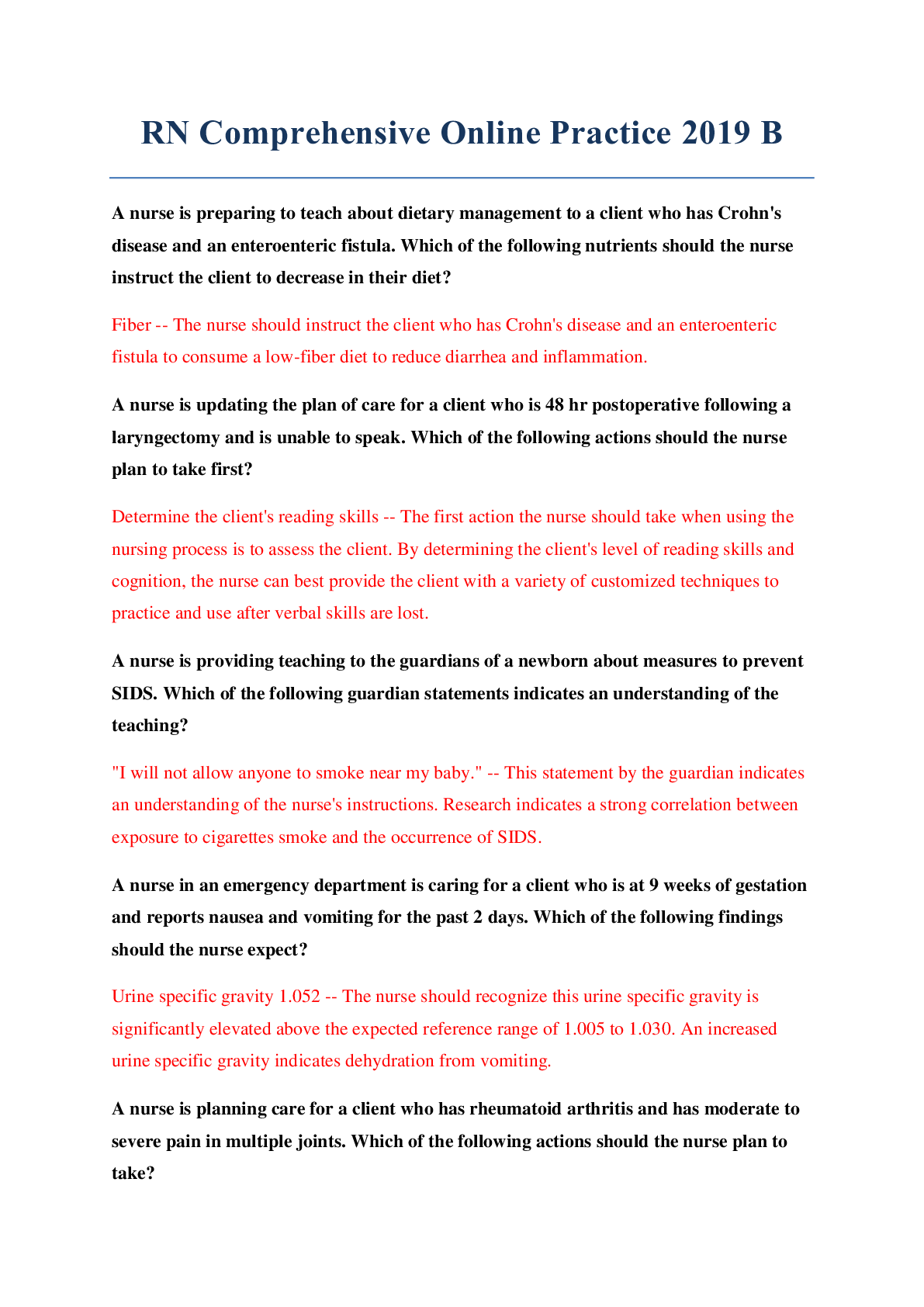






.png)
